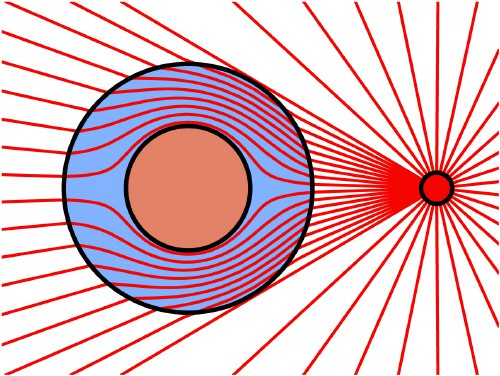Forget Harry Potter and his "invisibility cloak" -- theoretical physicists in the UK and US have proposed a clever way of making objects invisible. It would involve surrounding the object by a "metamaterial" -- a type of composite material that has unusual electromagnetic properties. According to the researchers, light rays incident on the material would be bent around the object, only to emerge on the other side in exactly the same direction as they began. Although the work is only theoretical, the researchers reckon that materials invisible to radio waves could be produced within five years.

Composed of tiny rods, ensembles of metal rings and the like, metamaterials are artificially structured composite materials that were first made by David Smith, now at Duke University, and colleagues in 2000. What makes them unusual is that they have a negative refractive index – that is, they bend light in the “opposite” direction to ordinary materials. Their electromagnetic properties can also be “tuned” by manipulating their precise structure.
John Pendry of Imperial College London — working with Smith and his Duke colleague David Schurig — has now shown how metamaterials could guide light around a hole within it. Any object placed inside this hole would then be “hidden” because light can not reach it and you would be able to see behind the object as if it was not there. All light rays that come from one direction would propagate around the hole and then be recombined as if nothing were there, a bit like water flowing round a rock. Working independently, Ulf Leonhardt of the University of St Andrews in the UK has also come to the same conclusion.
The new calculations involved placing a hole in a material and then calculating, using Maxwell’s equations, what properties the material would need to have to divert light around it. For this to happen, the material would have to be designed so that the light travels relatively slowly far from the hole and faster as it travels near the hole. (In fact, the light would have to travel infinitely fast when it brushes along the surface of the hole itself, although this would not violate relativity provided the radiation is within a certain frequency band.) Metamaterials would allow this vision to become reality because they can be designed such that the refractive index — and hence the speed of light — varies from point to point.
Although the new results are only calculations, the researchers hope that it will be possible for others to make the metamaterials that can produce the required variations in light speed. This may not be as difficult as it sounds because physicists already know how to design metamaterials that have such properties for radio waves. Indeed, “cloaking” devices for this part of the electromagnetic spectrum could appear in as little as five years, the team says. Such devices could have all sorts of applications in defence and wireless communication.
“This research shows how much electromagnetic or optical instruments can do if there are no limits on the electromagnetic or optical properties of materials,” says Leonhardt. “In practice, there are of course limitations. This research is likely to inspire a new wave of research in metamaterials.”
Interestingly, the new calculations are inspired by the geometry of curved space — a discipline that is normally in the firm hands of researchers in general relativity. “Here we have examples where ideas of general relativity are put to practical use in electrical or optical engineering and nanotechnology,” says Leonhardt. “Isn’t that surprising?”
Schurig is equally excited by the new work. “We have a new paradigm for designing devices that interact with electromagnetic waves,” he says. “It is impossible to imagine all the applications that will stem from this.”




